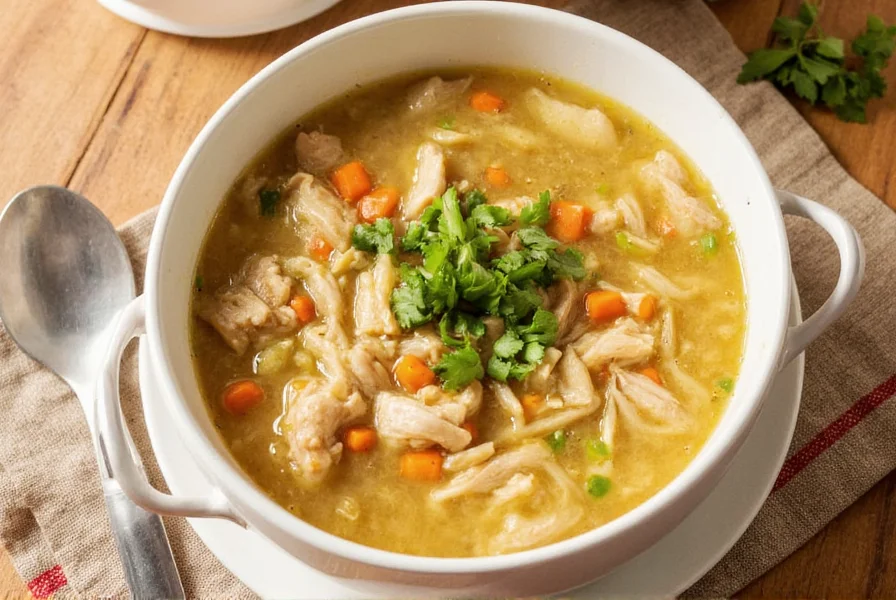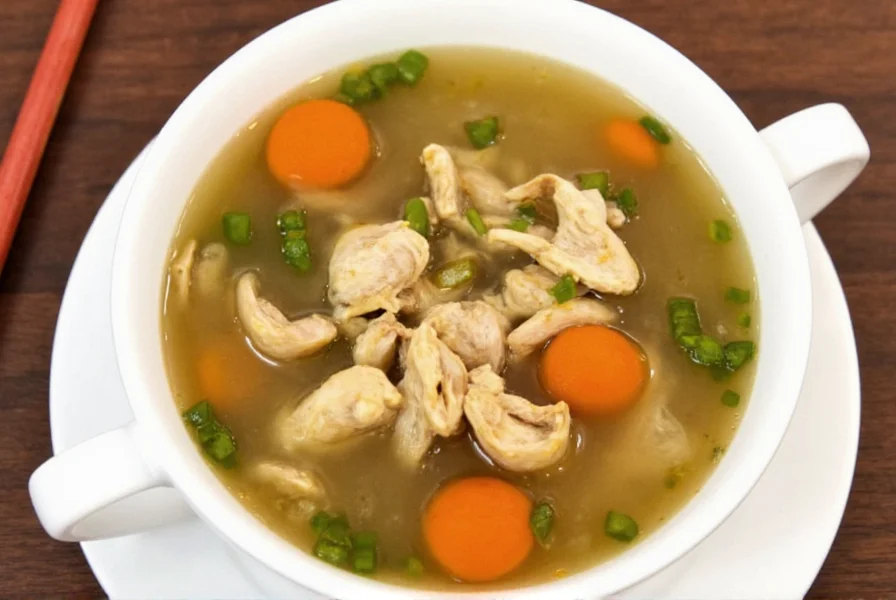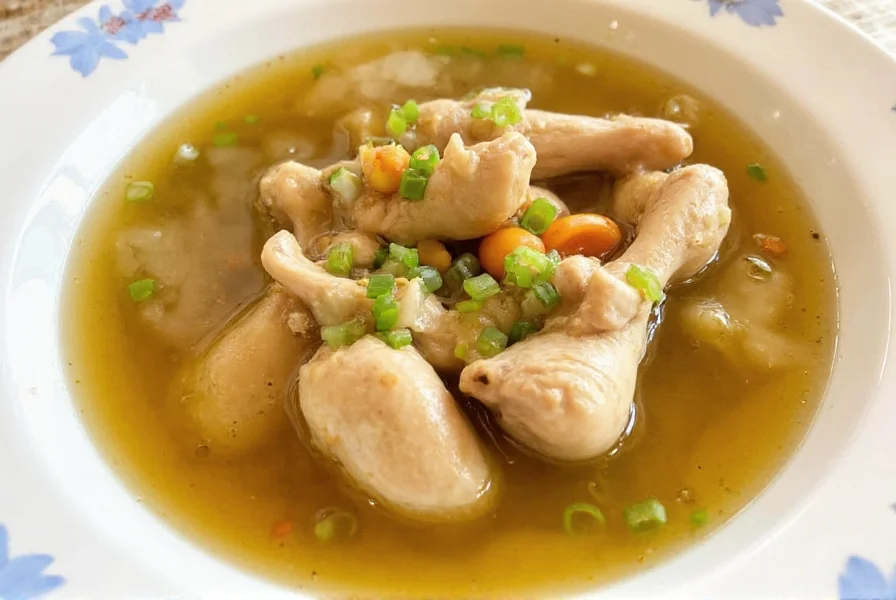Chicken and ginger soup represents one of the world's most enduring comfort food traditions, spanning multiple cultures with remarkable consistency in its core ingredients. While variations exist across Asian cuisines particularly, the fundamental combination of chicken and ginger creates a uniquely balanced flavor profile that has sustained its popularity for centuries.
Cultural Origins and Global Adaptations
This simple yet sophisticated soup traces its origins to ancient Chinese culinary traditions, where it was valued both for its taste and perceived medicinal properties. Traditional Chinese Medicine practitioners historically recommended chicken and ginger soup for recovery from illness and to promote circulation. As Chinese communities migrated worldwide, they brought this culinary treasure with them, adapting it to local ingredients while maintaining the essential ginger-chicken partnership.
Today, you'll find distinctive versions across Asia: In Korea, Samgyetang features a whole young chicken stuffed with glutinous rice, ginseng, and红枣 (red dates) with ginger playing a supporting role. Japanese tori-jiru often includes miso and vegetables alongside the ginger-chicken base. Southeast Asian variations frequently incorporate lemongrass and other regional herbs while preserving the ginger foundation.
Understanding the Key Ingredients
The magic of authentic chicken and ginger soup lies in the careful selection and preparation of its core components. Let's examine what makes each element essential:
| Ingredient | Role in Soup | Selection Tips |
|---|---|---|
| Chicken | Provides protein, richness, and body to the broth | Use bone-in pieces (thighs, wings) for maximum flavor and collagen |
| Fresh Ginger | Imparts distinctive warmth, aroma, and potential health benefits | Select firm, smooth-skinned roots; avoid shriveled or moldy specimens |
| Water/Broth | Medium for extraction and flavor development | Cold, filtered water yields clearest broth; avoid pre-seasoned stocks |
| Supporting Elements | Enhance complexity without overpowering | Scallions, garlic, and minimal salt typically suffice |
When selecting ginger for chicken ginger soup, look for plump roots with smooth, taut skin. Younger "spring ginger" offers milder flavor, while mature ginger provides more intense heat—choose based on your preference. Properly stored in the refrigerator, fresh ginger remains viable for up to three weeks.
Health Benefits: Separating Fact from Folklore
While traditional medicine systems have long praised chicken and ginger soup, modern science offers insights into its potential benefits. Ginger contains bioactive compounds like gingerol, which research suggests may help reduce inflammation and support digestive health. A 2013 review published in Nutrition Journal noted ginger's potential role in managing nausea and supporting immune function.
Chicken soup's reputation as a cold remedy may have scientific merit. A 2000 study in Chest found that chicken soup might inhibit neutrophil migration, potentially reducing inflammation associated with upper respiratory infections. The steam from hot soup can help clear nasal passages, while the hydration supports overall recovery.
It's important to note that while chicken and ginger soup offers nutritional value, it shouldn't replace medical treatment for serious conditions. As a nourishing food, it complements wellness practices rather than serving as a standalone remedy.
Traditional Preparation Techniques
Authentic chicken ginger soup preparation follows principles that maximize flavor extraction while maintaining clarity and balance. The traditional Chinese method involves several critical steps that differentiate it from Western-style chicken soups:
- Blanching the chicken: Briefly boiling bone-in chicken pieces then rinsing removes impurities that could cloud the broth
- Simmering, not boiling: Maintaining a gentle simmer (180-200°F) prevents emulsification of fats that would make the broth cloudy
- Ginger preparation: Slicing rather than mincing ginger controls its intensity; some traditions call for lightly charring the ginger first
- Timing: Chicken simmers for 1-2 hours to extract collagen without overcooking the meat
- Seasoning at the end: Salt added late preserves the delicate flavor balance
These techniques produce the characteristic clear broth with subtle ginger warmth that defines authentic chicken ginger soup, distinguishing it from heartier, more heavily spiced variations.
Classic Chicken Ginger Soup Recipe
Creating an authentic chicken and ginger soup requires attention to detail but remains accessible for home cooks. This traditional preparation yields four servings:

Ingredients
- 1.5 lbs (680g) bone-in chicken pieces (thighs or wings preferred)
- 2 inches (5cm) fresh ginger, peeled and sliced
- 8 cups (2 liters) cold filtered water
- 2 scallions, white parts only, cut into 2-inch pieces
- 1 teaspoon salt (added at the end)
- Optional: 1-2 red dates (jujubes) for subtle sweetness
Preparation
- Place chicken in a large pot, cover with cold water, and bring to a boil. Simmer for 3 minutes, then remove chicken and rinse under cold water.
- Return clean chicken to pot with 8 cups cold water. Add ginger and scallions.
- Bring to a gentle simmer (do not boil vigorously) and skim any foam that rises to the surface.
- Cover and simmer for 60-90 minutes until chicken is tender and broth has developed flavor.
- Remove chicken, strain broth through a fine-mesh sieve, and return clear broth to clean pot.
- Add salt to taste and return chicken to broth to warm through.
- Serve hot, optionally garnished with fresh scallion greens.
This traditional chicken and ginger soup preparation creates a delicate yet flavorful broth that showcases the natural synergy between these ingredients. For those seeking how to make authentic chicken ginger soup with minimal ingredients, this recipe demonstrates that simplicity often yields the most satisfying results.
Regional Variations Worth Exploring
While the Chinese version remains the most influential, regional adaptations offer distinctive interpretations worth trying:
- Hainanese Chicken Soup: Features poached chicken with ginger-scallion oil, served with clear ginger broth on the side
- Korean Samgyetang: Whole young chicken stuffed with glutinous rice, ginseng, and红枣, simmered with ginger
- Taiwanese Ginger Chicken: Uses darker meat chicken with generous amounts of black vinegar and sesame oil
- Vietnamese Ga Trong Mam Tom: Incorporates shrimp paste and fish sauce alongside the ginger-chicken base
Each variation maintains the essential ginger-chicken partnership while incorporating local flavors and techniques. When exploring these authentic chicken ginger soup variations, note how different cultures balance the ginger's intensity to match regional palates.
Serving and Storage Recommendations
For optimal enjoyment of homemade chicken ginger soup, serve immediately while hot in pre-warmed bowls. The traditional Chinese approach serves the soup as a first course to stimulate the appetite, though it also functions beautifully as a light main course.
Proper storage maintains quality and safety:
- Cool soup quickly by placing the pot in an ice bath before refrigerating
- Store in airtight containers for up to 4 days in the refrigerator
- Freeze in portion-sized containers for up to 3 months
- Reheat gently without boiling to preserve delicate flavors
When reheating chicken ginger soup for colds or general wellness, avoid adding additional salt as the flavors concentrate during storage. The collagen-rich broth may gel when chilled—a sign of proper extraction that liquefies when reheated.
Perfecting Your Chicken Ginger Soup Technique
Mastering this deceptively simple soup requires attention to several subtle elements that distinguish adequate from exceptional preparations:
- Bone selection matters: Chicken feet or wings add significant collagen for a richer mouthfeel without overpowering flavor
- Ginger preparation affects intensity: Slicing provides milder flavor than mincing; charring ginger first creates deeper, smokier notes
- Water quality impacts clarity: Filtered water produces the cleanest-tasting, clearest broth
- Simmering temperature is critical: Maintain just below boiling point (180-200°F) for optimal extraction without cloudiness
- Timing prevents bitterness: Remove ginger after 45 minutes if using mature, fibrous roots to avoid developing bitter compounds
These refinements transform a basic chicken ginger soup preparation into a restaurant-quality dish that showcases the nuanced relationship between these core ingredients. For those exploring how to make authentic chicken ginger soup with professional results, these details make the crucial difference.

Conclusion
Chicken and ginger soup represents culinary wisdom passed through generations—a testament to how simple ingredients, properly prepared, create something greater than the sum of their parts. This traditional preparation continues to earn its place in kitchens worldwide not through exotic ingredients but through its fundamental understanding of flavor balance and nourishment.
Whether seeking comfort during illness, a light meal, or simply appreciating culinary tradition, mastering this soup offers rewards that extend beyond the bowl. The most authentic chicken ginger soup requires no special equipment or hard-to-find ingredients—just attention to technique and respect for the ingredients' natural qualities.
What's the best type of chicken for ginger soup?
Bone-in chicken pieces like thighs, wings, or drumsticks work best for ginger soup as they release collagen and flavor during simmering. Chicken feet are particularly valued in traditional Chinese preparations for their high collagen content, which creates a richer, more viscous broth without overpowering the delicate ginger flavor.
How long should I simmer chicken ginger soup?
For optimal flavor extraction without cloudiness, simmer chicken ginger soup gently for 60-90 minutes. Vigorous boiling will emulsify fats and create a cloudy broth. The soup is ready when the chicken is tender but not falling apart, and the broth has developed a subtle golden hue with clear separation of ingredients.
Can chicken ginger soup help with cold symptoms?
While not a medical treatment, chicken ginger soup may provide symptomatic relief during colds. The steam helps clear nasal passages, the hydration supports recovery, and ginger contains compounds that may help reduce inflammation. A 2000 study in Chest journal suggested chicken soup might inhibit certain inflammatory responses, though more research is needed on specific health benefits.
Why is my chicken ginger soup cloudy?
Cloudiness typically results from boiling the soup too vigorously, which emulsifies fats into the broth. To prevent this, maintain a gentle simmer rather than a rolling boil. Starting with cold water, blanching the chicken first, and skimming impurities during initial heating also contribute to a clearer broth. If your soup is already cloudy, straining through a fine-mesh sieve or cheesecloth can help clarify it.
How can I adjust ginger intensity in the soup?
To control ginger intensity, adjust both the amount and preparation method. For milder flavor, use younger ginger, slice rather than mince, and add it later in the cooking process. For stronger ginger presence, use mature ginger, mince or crush it, and add it at the beginning. Charring the ginger first creates deeper, smokier notes without increasing heat level. Remember that ginger flavor continues to develop as the soup sits, so err on the side of less intense when first preparing.











 浙公网安备
33010002000092号
浙公网安备
33010002000092号 浙B2-20120091-4
浙B2-20120091-4